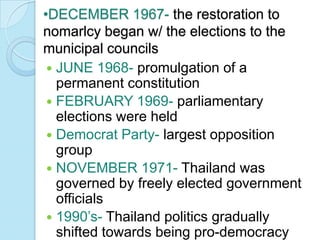
December 1967 the restoration to nomarlcy began w
- 1. •DECEMBER 1967- the restoration to nomarlcy began w/ the elections to the municipal councils JUNE 1968- promulgation of a permanent constitution FEBRUARY 1969- parliamentary elections were held Democrat Party- largest opposition group NOVEMBER 1971- Thailand was governed by freely elected government officials 1990’s- Thailand politics gradually shifted towards being pro-democracy
- 2. •Srimaung Chamlong- leader of the Buddhist Palang Dharma Party Gen. Suchida Kraprayoon- leader of the military faction Banham Silpa Archa- first democratically elected prime minister in the Thailand. - under his leadership, the first democratically- appointed senate began. - he is forced to resign in Sept. 1996 due to the corruption led to the collapse of the Palang Dharma and
- 3. THAILAND IN WORLD POLITICS June 1950- the country sent 4000 of it’s soldier as peacekeeping forces during Korean War April 1954- Geneva convention, Thailand representatives took an active part in an attempt to end Indochina War Sept. 1954- founding member of the SEATO Bangkok- made headquarters of the organization
- 4. •In early 1960’s 11,000 Thailand forces were sent to support South Vietnam against the communist Vietcong and North Vietnamese troops. External threats increased in 1995 Burmese and Cambodian troops clashed along it’s borders and to some point pursued each other’s insurgents within Thailand territory. 1997- Thailand suffer an inflation rate of 107 percent putting its economy in total collapse